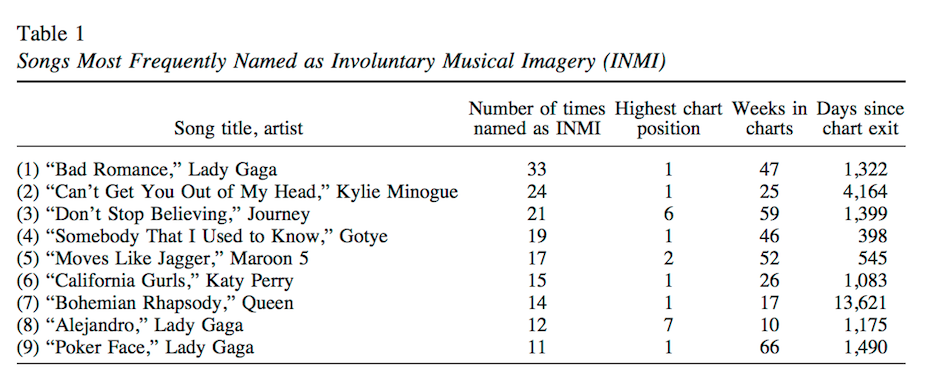Title of paper under discussion
Dissecting an Earworm: Melodic Features and Song Popularity Predict Involuntary Musical Imagery
Authors
Kelly Jakubowski, Lauren Stewart, Sebastian Finkel, Daniel Müllensiefen
Journal
Psychology of Aesthetics, Creativity, and the Arts, 2017, Vol. 11, No. 2, 122–135
Link to original paper (open access)
Overview
Earworms – melodies that enter your head involuntarily and don’t seem to want to leave – fascinate musician scientists, keen to discover what aspects of a tune make it more likely to ‘stick’. This team of authors, from London, Tübingen and Aarhus, found popularity, faster tempo, common melodic contour and rare ‘gradient of melodic turning point’ all made earworminess more likely in a tune.
Previous research
They open by citing past literature relevant to the study of the earworm (referred to throughout by its scientific name ‘involuntary musical imagery – INMI’). Recent exposure and familiarity had already been described as factors likely to make a tune become an earworm, as well as ‘singability’ due to longer notes and smaller pitch intervals. Findings on qualities similar to earworminess – musical catchiness, song memorability and common features of hit songs – are also presented, describing how, for example, musical catchiness depends on prominence of the vocal line, song memorability depends on timing distinctiveness and hit songs often exhibit a large pitch range. All such research involves describing a melody in terms of its different features – note lengths, pitch range, tempo etc. – melodic features that scientists put into two classes: first order and second order..
First order and second order features of melodies
A first order melodic feature is one based on “the intrinsic content of a melody itself”, e.g. its tempo, its average note value or its pitch range. In contrast, second order melodic features “compare a melody to a larger collection or corpus of melodies (generally comprised of music from the same genre or style as the melodies that are being analyzed, such as pop songs or folk songs)”; so, for example, how common the pitch range of that melody is in comparison to those of a large collection of comparable melodies. Such comparisons with a huge number of other melodies are possible thanks to software, developed in 2009, called FANTASTIC (Feature ANalysis Technology Accessing STatistics In a Corpus).
Experiment
The research team asked 3,000 people to name their most common and most recent earworms. These earworms were all ranked according to position and recency in the Pop charts.

Putting these data into four separate statistical models the team found that both the popularity and the recency of a tune were significant predictors as to whether it might become an earworm (INMI).
The next step was to investigate whether any particular melodic features of these earworms, distinct from their popularity and recency, were key to making them ‘sticky’. This led to a search for melodies that were equally as popular and recent as the earworm melodies but which hadn’t been named as earworms by any of the 3,000 participants; they found 101 such popular and recent (but non-earworm) tunes. Any significant differences between these 101 non-earworms and an equal number of earworms could then be fairly described as contributing to the stickiness, or earworminess, of a melody.
83 different melodic features were put into this comparison, including first order features such as pitch range, and second order features such as how common that pitch range is in pop music generally. The corpus for making these second order comparisons contained 14,063 songs, giving high confidence to any findings.
Results
Three melodic features emerged from the statistical analysis as significant predictors of earworm status: 1) a “common global contour”, meaning the overall shape of the melody (e.g. arch form, found in a lot in the earworms) was also one commonly found in pop music 2) an “uncommon average gradient at turning points in the melody” meaning earworms contain steeper rises or falls at points of melodic inflection than is usually found in pop songs and 3) a faster tempo, with the earworms over 9 bpm quicker than the non-earworms on average.
Further analysis showed that whereas popularity and recency of a tune predicted how many times it would be named as an earworm, the three named melodic features each just predict whether it would be named as such.
Ideas for further research
A particularly interesting line of enquiry proposed for further research following on from the tempo finding is whether songs than are more easily “entrained” to the tempos found in everyday life are those that become earworms, seeing as many participants reported earworms during walking or running. Also proposed is an expansion of the analysis to include 1) variables such as loudness, timbral content, rhythmic clarity, 2) more compositional features such as the harmonic content or chord structure of the music, articulation, and expressive timing, 3) lyrical content such as rhyme or alliteration, 4) more recent pop music as part of the corpus for comparison and 5) other genres of music e.g. classical
Coda
Can’t get you out of my head – Kylie Minogue